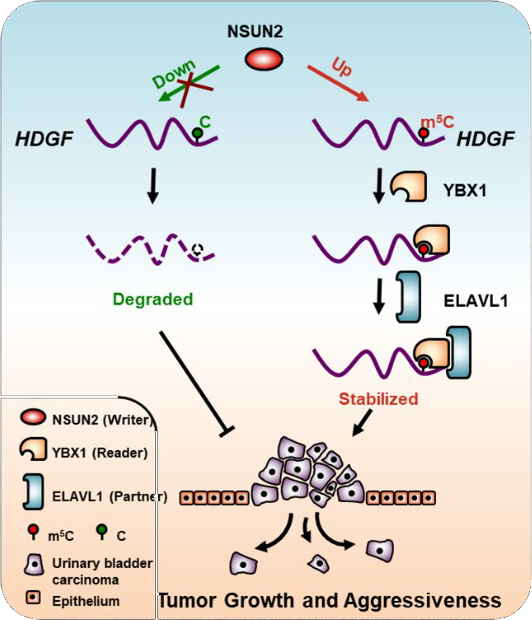5-methylcytosine (m5C) is one of the most abundant and important modifications in mRNA. Prof. YANG Yungui’s group at Beijing Institute of Genomics of the Chinese Academy of Sciences (CAS) has employed a single-base resolution sequencing approach for RNA m5C modification to reveal the transcriptome-wide m5C profiles in mammalian cells and tissues and illustrate an essential role of m5C in regulating mRNA export mediated by its reader protein ALYREF. But how m5C regulates the fate of cytoplasmic mRNAs and their regulatory functions under physiological and pathological conditions remains unknown. A recent study led by Prof. YANG Yungui, in collaboration with Prof. ZHOU Fangjian and Prof. XIE Dan from Sun Yet-sen University Cancer Center, and Prof. HUANG Ying from Shanghai Institute of Biochemistry and Cell Biology of the CAS, revealed that RNA m5C modification maintains mRNA stability through a novel cytoplasmic m5C reader YBX1 and further promotes the pathogenesis of human urothelial carcinoma of the bladder (UCB). The research has been published online in Nature Cell Biology on July 29. The team first provided the single-nucleotide resolution landscape of mRNA m5C modification in human UCB, and found that m5C is frequently hypermethylated in UCBs and enriched in oncogenic pathways. Moreover, the m5C modification of mRNA might be implicated in the invasiveness and metastasis of UCBs. They further identified a novel cytoplasmic m5C binding protein YBX1, which recognizes m5C-modified mRNAs through the indole ring of W65 in its cold-shock domain, and regulates the RNA binding affinity of the mRNA stabilizer ELAVL1 in an m5C-dependent manner. They also demonstrated that the mRNA m5C methyltransferase NSUN2 and YBX1 are highly expressed in UCBs compared to the adjacent normal tissues. Further analyses revealed that NSUN2 and YBX1 target HDGF m5C and stabilize its mRNA to promote UCB pathogenesis. The findings revealed a novel regulatory mechanism of RNA m5C methylation in mediating oncogene activation in human UCB pathogenesis, providing a potentially valuable strategy for prevention and treatment of UCB, and meanwhile highlighting the potential biological significance of posttranscriptional modifications in both UCB and other tumors. Regulatory landscape of the NSUN2/YBX1-m5C-HDGF signaling axis in promoting the pathogenesis of UCB (Image by YANG Yungui's group) Contact: Dr. YANG Yungui Email: ygyang@big.ac.cn
